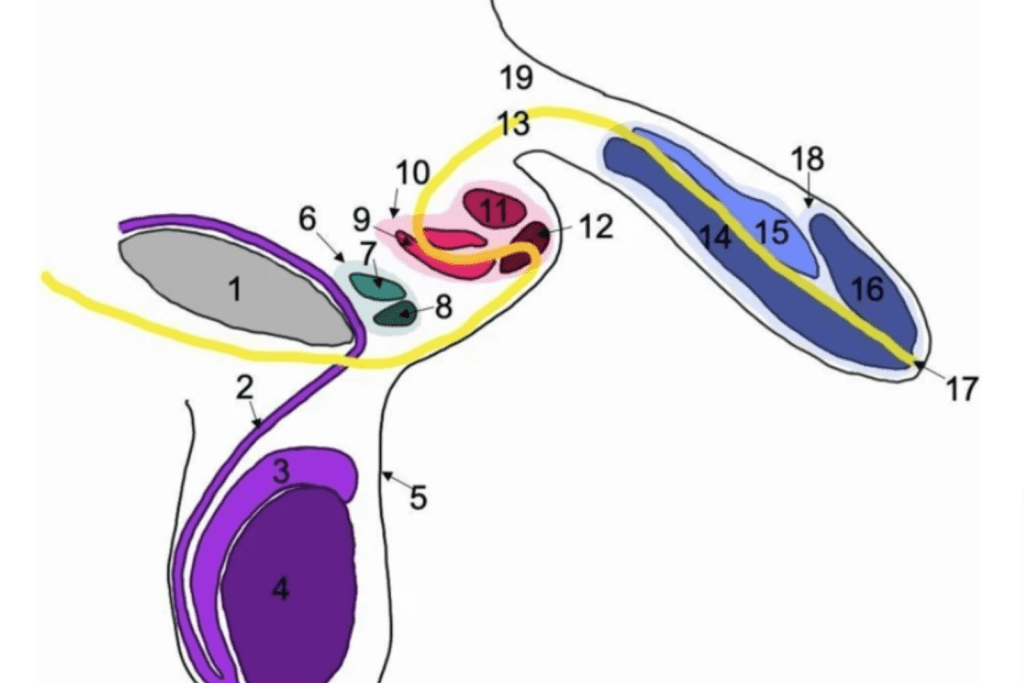Last Updated on November 25, 2025 by

Peyronie’s disease is when scar tissue forms inside the penis. This leads to a noticeable bend during an erection. The penis might bend up, down, or to one side. It can also cause pain or nodules. Many men first search what is Peyronie’s disease when they notice these changes, as the symptoms can be worrying.
Other conditions can have similar symptoms, like penile curvature or pain. This makes it hard to tell what’s wrong. Many conditions are mistaken for Peyronie’s because of these similar signs. This can lead to delayed treatment and more problems.
It’s important to know about these lookalike conditions. We’ll look at the common symptoms and how hard it is to diagnose Peyronie’s disease. This way, patients can get the right treatment for their condition.
Men with penile curvature or pain during an erection might have Peyronie’s disease. This condition is often misunderstood or misdiagnosed. It involves scar tissue inside the penis, causing curved erections and distress.
Peyronie’s disease symptoms include penile curvature, scar tissue, erectile dysfunction, pain, and penis shortening. The curvature can go up, down, or to the side. Downward curvature is often the most distressing for men.
Key symptoms to watch out for:
Up to 13% of adult men might show signs of Peyronie’s disease. Yet, only about 0.7% are officially diagnosed. This big gap shows how hard it is to accurately identify the condition.
The gap between symptoms and diagnoses is due to several reasons. Lack of awareness and the complexity of diagnosing Peyronie’s disease are key factors.
Misdiagnosis of Peyronie’s disease happens for many reasons. Symptoms can be like those of other conditions, making it hard to tell them apart. Also, some men might not want to talk about their issues, which can delay getting a diagnosis.
Factors contributing to misdiagnosis include:
Knowing these challenges is key to better diagnosis and care for men with Peyronie’s disease.
Congenital conditions can look like Peyronie’s disease, making it important to get a correct diagnosis. Peyronie’s disease causes a penis to curve due to scar tissue. But other conditions can also cause similar symptoms, making it hard to tell them apart.

Congenital penile curvature is when a penis is born curved. It’s often because of uneven growth in the penis. Unlike Peyronie’s, it doesn’t usually hurt or have a plaque. The main difference is the scar tissue and when symptoms start. Men with this condition notice it from puberty, while Peyronie’s starts later.
Medical experts say,
“Knowing how congenital penile curvature works is key to telling it apart from Peyronie’s disease.”
Getting the right diagnosis is important for the right treatment. This could be watching it, surgery, or other options.
Chordee is a condition that can be mistaken for Peyronie’s. It’s a penis curve linked to hypospadias. The curve in chordee comes from skin or uneven growth. Chordee is found in kids and fixed with surgery.
Other issues like penile torsion or ventral curvature can also be mistaken for Peyronie’s. A detailed check and knowing the patient’s history are key to a right diagnosis. Knowing the difference is important for the right treatment.
In summary, many congenital conditions can be mistaken for Peyronie’s disease. A precise diagnosis is essential. By knowing the differences, doctors can give the best treatment, helping patients get better.
Traumatic events can cause conditions mistaken for Peyronie’s disease. We’ll look at these conditions, their unique signs, and why correct diagnosis matters.
A penile fracture is a serious injury that happens when the tunica albuginea ruptures. It often occurs during sex. The symptoms are immediate and severe, unlike Peyronie’s disease. Yet, if not treated quickly, it can cause long-term problems like fibrosis and curvature, similar to Peyronie’s.
“The diagnosis of penile fracture is mainly based on symptoms and physical check-ups,” a study on Trauma and Acute Care explains. Knowing the difference between acute and chronic penile fracture is key to not confusing it with Peyronie’s disease.
Scarring and fibrosis after surgery can also be mistaken for Peyronie’s disease. These issues can arise from surgeries like circumcision or penile procedures. It’s important to tell them apart from Peyronie’s because their treatments are different.
Iatrogenic fibrosis after surgery can cause serious penile deformities. Accurate diagnosis is vital for the right treatment, whether it’s more surgery or other methods.
Understanding the patient’s history and the nature of the deformity helps in making the right diagnosis. This ensures the best treatment and better outcomes for the patient.
Neoplastic conditions, like penile cancer, can look like Peyronie’s disease. This makes it important to get a correct diagnosis. Peyronie’s disease, also known as “bent carrot disease,” has symptoms that can be confused with penile cancer and other conditions.
Primary penile tumors can be mistaken for Peyronie’s disease. They share symptoms like penile curvature or pain. But, they have unique features, such as:
It’s key to tell primary penile tumors apart from Peyronie’s disease. Their treatments and outcomes are different. Early diagnosis is critical for the best treatment.
Metastatic disease to the penis can also be mistaken for Peyronie’s disease. It’s rare but can happen from cancers in other areas, like the prostate or bladder. Symptoms include:
Accurate diagnosis needs a detailed check-up and tests. Knowing the patient’s medical history and using imaging studies are key steps.
In summary, conditions like penile cancer and metastatic disease to the penis can be confused with Peyronie’s disease. A thorough diagnostic approach is needed for the right diagnosis and treatment.
Getting a correct diagnosis is key to treating Peyronie’s disease and similar conditions. We’ve talked about how some conditions can look like Peyronie’s. This includes both birth defects and injuries, as well as cancerous diseases.
There are several ways to treat Peyronie’s disease. These include peyronie’s disease surgery, shockwave therapy, and other non-surgical methods. The cost of peyronie’s disease surgery can change a lot. It depends on the type of surgery and where it’s done.
For those with mild peyronie’s, simple treatments might work. But, if the curve is severe, more serious treatments like surgery might be needed.
It’s very important to see a doctor who knows what they’re doing. This ensures you get the right diagnosis and treatment. Knowing about all the treatment options helps you make the best choice for your health.
Peyronie’s disease is a condition where scar tissue forms in the penis, causing it to curve. Unlike normal curvature, Peyronie’s disease is painful and affects erections. It also impacts quality of life significantly.
Symptoms include penile curvature, pain during erections, and trouble getting or keeping an erection. Some people also feel a hard lump or scar tissue.
Yes, congenital penile curvature can look like Peyronie’s disease. But, congenital conditions are present from birth and don’t cause pain or scar tissue.
Penile fracture and post-surgical scarring can be mistaken for Peyronie’s disease. These conditions have different symptoms and treatments than Peyronie’s disease.
Yes, primary penile tumors and metastatic disease can look like Peyronie’s disease. They can cause penile curvature or masses. It’s important to get an accurate diagnosis.
Treatment for Peyronie’s disease varies. It can range from medication to surgery, depending on the symptoms and how it affects daily life.
A detailed medical check-up is needed to figure out the cause of penile curvature. A urology specialist is best for an accurate diagnosis.
Peyronie’s disease is not very common, with estimates ranging from 0.7% to 13%. Accurate diagnosis and awareness are key to treating it effectively.
Yes, treatment varies with the severity of symptoms. Mild cases might be treated with medication, while severe cases might need surgery.
Lacarrière, E., Galliot, I., Gobet, F., & Sibert, L. (2012). Leiomyosarcoma of the corpus cavernosum mimicking a Peyronie’s plaque. Urology, 79(4), e53-e54. https://doi.org/10.1016/j.urology.2011.07.1410
Dai, Y., et al. (2023). Penile metastasis from prostate cancer misdiagnosed as Peyronie’s disease. PMCID Article. https://doi.org/10.1186/s12894-023-01327-2
Hurrell, C., Irving, S., Shaw, M., Ball, R. Y., & Chitale, S. (2012). Primary penile cancer + Peyronie’s disease = Diagnostic difficulty: A case of delayed diagnosis with a review of the problem of penile neoplasms masquerading as, or being masked by, Peyronie’s disease. The Open Urology & Nephrology Journal, 5, 24-27. https://doi.org/10.2174/1874303X01205010024
ScienceDirect Topics. (n.d.). Penis tumour “ an overview. In Medicine and Dentistry Topics. ScienceDirect. Retrieved from https://www.sciencedirect.com/topics/medicine-and-dentistry/penis-tumor
Subscribe to our e-newsletter to stay informed about the latest innovations in the world of health and exclusive offers!